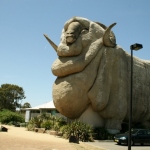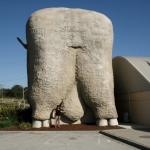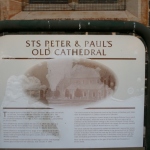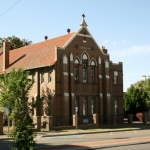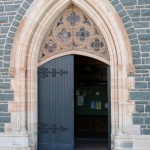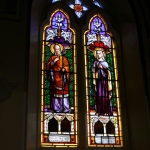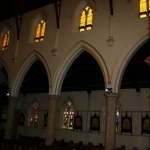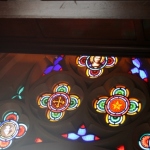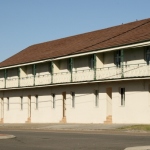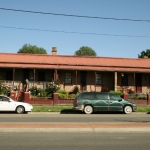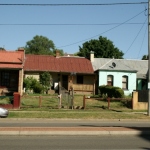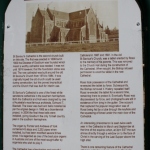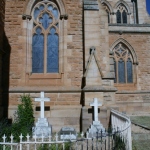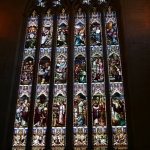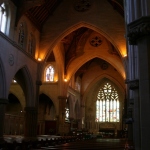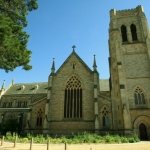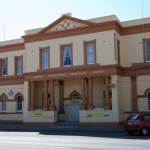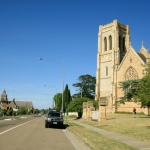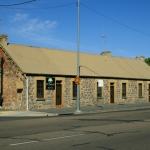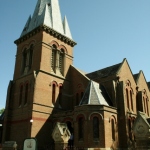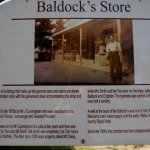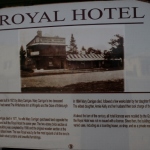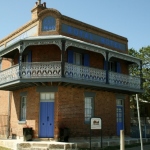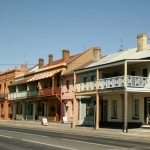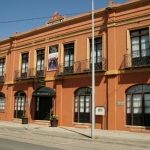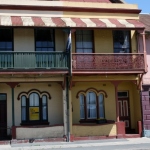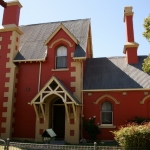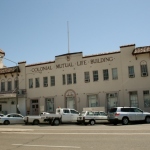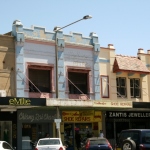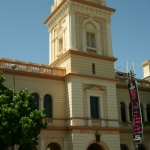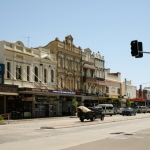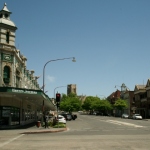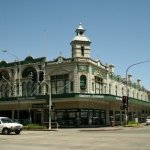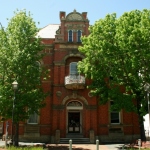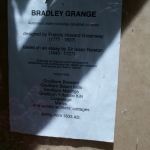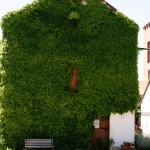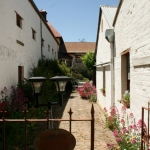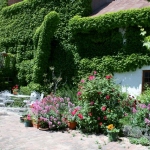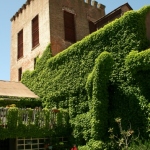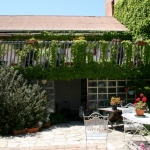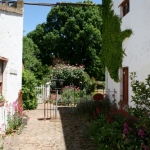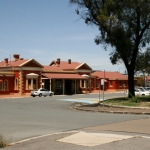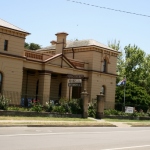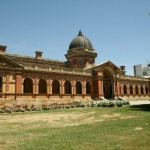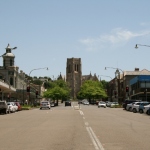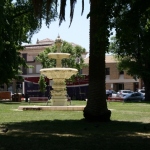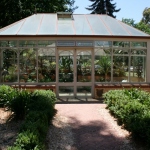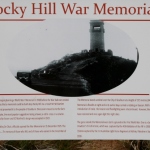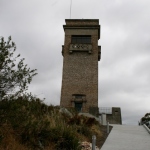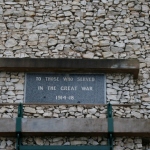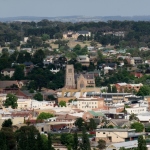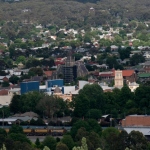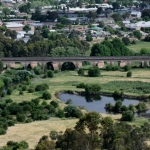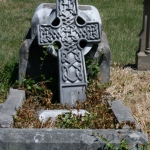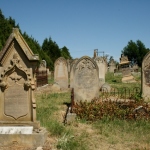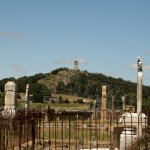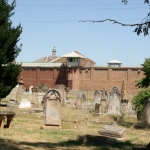Goulburn (wikpedia)
is a regional city in the Southern Tablelands of New South Wales, Australia approximately 195 kilometres (121 mi) south-west of Sydney, Australia, and 90 kilometres (56 mi) north-east of Canberra. Goulburn is Australia’s first inland city. At the 2011 Census, Goulburn had a population of 21,484 people. Goulburn is the seat of Goulburn Mulwaree Council.
Goulburn is a railhead on the Main Southern line and service centre for the surrounding pastoral industry and a stopover for those travelling on the Hume Highway. It has a central park and many historic buildings. It is also home to the Big Merino, the world’s largest concrete sheep.
History
Goulburn was named by surveyor James Meehan after Henry Goulburn, Under-Secretary for War and the Colonies, and the name was ratified by Governor Lachlan Macquarie. The Aboriginal name for Goulburn is Burbong, a Murring/Wiradjuri word indicating a special Indigenous cultural area.
1800s
The colonial government made land grants to free settlers such as Hamilton Hume in the Goulburn area from the opening of the area to settlement in about 1820. Land was later sold to settlers within the Nineteen Counties, including Argyle County (the Goulburn area). The process displaced the local indigenous Gandangara population and the introduction of exotic livestock drove out a large part of the Aborigines’ food supply.[citation needed] The reduction of the food supply and the accidental introduction of exotic diseases, substantially reduced the local indigenous population. Some local Aborigines survived at the Tawonga Billabong Aboriginal Settlement established under the supervision of the Tarago police. In the 1930s the local billabong dried up and the Aboriginal people moved away although some have, over time, made their way back.
The first recorded settler in Goulburn established ‘Strathallan’ in 1825 (on the site of the present Police Academy) and a town was originally surveyed in 1828, although moved to the present site of the city in 1833 when the surveyor Robert Hoddle laid it out. George Johnson purchased the first land in the area between 1839 and 1842 and became a central figure in the town’s development. He established a branch store with a liquor licence in 1848. By 1841 Goulburn had a population of some 1,200 – a courthouse, police barracks, churches, hospital and post office and was the centre of a great sheep and farming area.
A telegraph station opened in 1862, by which time there were about 1,500 residents, a blacksmith‘s shop, two hotels, two stores, the telegraph office and a few cottages. The town was a change station (where coach horses were changed) for Cobb & Co by 1855. A police station opened the following year and a school in 1858. Goulburn was proclaimed a municipal government in 1859 and was made a city in 1863. Goulburn holds the unique distinction of being proclaimed a City on two occasions. The first, unofficial, proclamation was claimed by virtue of Royal Letters Patent issued by Queen Victoria on 14 March 1863 to establish the Diocese of Goulburn. It was a claim made for ecclesiastical purposes, as it was required by the traditions of the Church of England. The Letters Patent also established St Saviour’s Church as the Cathedral Church of the diocese. This was the last instance in which Letters Patent were used in this manner in the British Empire, as they had been significantly discredited for use in the colonies, and were soon to be declared formally invalid and unenforceable in this context.[4] Several legal cases[5] over the preceding decade in particular had already established that the monarch had no ecclesiastical jurisdiction in colonies possessing responsible government. This had been granted to NSW in 1856, seven years earlier. The Letters Patent held authority only over those who submitted to it voluntarily, and then only within the context of the Church – it had no legal civil authority or implications. An absolute and retrospective declaration to this effect was made in 1865 in the Colenso Case, by the Judiciary Committee of the Privy Council. However, under the authority of the Crown Lands Act 1884 (48. Vict. No. 18), Goulburn was officially proclaimed a City on 20 March 1885[7] removing any lingering doubts as to its status. This often unrecognised controversy has in no way hindered the development of Goulburn as a regional centre, with an impressive court house (completed in 1887) and other public buildings, as a centre for wool selling, and as an industrial town.
The arrival of the railway in 1869, which was opened on 27 May by the Governor Lord Belmore (an event commemorated by Belmore Park in the centre of the city), along with the completion of the line from Sydney to Albury in 1883, was a boon to the city. Later branchlines were constructed to Cooma (opened in 1889) and later extended further to Nimmitabel and then to Bombala, and to Crookwell and Taralga. Goulburn became a major railway centre with a roundhouse[9] and engine servicing facilities and a factory which made pre-fabricated concrete components for signal boxes and station buildings. The roundhouse is now a railway museum with steam,diesel and rolling stock exhibits.
St Saviour’s Cathedral, designed by Edmund Thomas Blacket, was completed in 1884 with the tower being added in 1988 to commemorate the Bicentenary of Australia. Though completed in 1884, some earlier burials are in the graveyard adjacent to the Cathedral. St Saviour’s is the seat of the Bishop of Canberra and Goulburn. The Church of SS Peter and Paul is the former cathedral for the Roman Catholic Archdiocese of Canberra and Goulburn.
Goulburn is located a small distance east of the peak ridge of the Great Dividing Range and is 690 metres (2,264 ft) above sea-level. It is intersected by the Wollondilly River and the Mulwaree River, and the confluence of these two rivers is also located here, which then flows north east, into Lake Burragorang (Warragamba Dam) and eventually into the ocean via the Hawkesbury River.
8th November, Saturday
We left a bit later than usual because we had to wait for the tractor to pull us out of Sardineville. Actually it was not a bad place, just a bit squashed in. Most people here all know each other and I think that they bring their vans up on weekends because they mainly live in Sydney so it’s not far for them to travel. The drive to Goulburn is not particularly exciting as it’s all highway (M1, M7 and the Hume Highway). We went through 2 tolls on the M2 and the M7 and they give you the no. to call or the website on the side of the road so that you know how to pay for it. They give you 3 days to pay. We got caught in Brisbane because we forgot all about it and a $3 toll landed up costing us $13.50 – go figure. When we got to the caravan park we tried to pay this frigging toll online because we didn’t want to be slugged with a huge fine again. We went onto the site and it says that you needed to insert you tag into whatever (I’d really like to tell them where to insert it). We trawled through the site trying to find out how to pay and it wasn’t easy, so I thought that I would call the no. that was on the billboard. I eventually get through to some call centre in Timbuktu and she tells me that I have to register. I try and explain that we won’t come back and it’s a one off thing but all I hear is “You have to register”, so, back to the frigging internet and we register the licence plate no. how many times you go to the toilet etc. etc. and then, pay an extra $1.50 for registration so you can pay this frigging toll without being fined, NOT HAPPY JAN. Anyways, the caravan park, I think is a bit of a redneck place. I can hear whips being cracked over the fence and some of the vans here look like people have been living here forever. We haven’t seen anything yet but will go out and about tomorrow as there is a lot of History here and YES, you guessed it……. Lots of old buildings, (HAHA). Goulburn is the first inland city, so I’m warning you beforehand about the photos to come. The weather is surprisingly warm seeing as we are only an hour from Canberra. I’m probably wrong but I thought that it was supposed to be a lot cooler here and we have the air con running.
9th November, Sunday
It’s another pretty hot day today. We are thinking that the hot air is all coming from Canberra seeing as we are only 1 hour away ;-). Goulburn is a very historical town and probably one of the oldest towns that we have seen so far. They locals are very proud of this heritage and fight to keep the town as it is. I’m glad about that because we are too busy pulling down history and replacing it with modern meaningless ugly buildings. We visited some art galleries today, lots of different kinds of art. The main gallery is closed but will be open tomorrow so we will give that a visit. There is a giant concrete Merino ram in town, because this is all wool country. The big boy is quite well endowed, Haha, as you will see from the photo. We found a very old brewery and the buildings are all original. The guy has heaps of chooks so sells his beer as well as the free range eggs. Ralph found an old second hand book shop and said that it was the biggest book shop that he had every seen. There were 15 rooms of books and nothing in order so he spent ages browsing while Hugo and I went for a walk around town. There are a lot of old churches here, 2 of them have the most beautiful stained glass windows. These churches are by far the oldest I’ve seen in Australia to date and they are beautiful. We drove to a little historical town called “Marulan”, these little historical towns are all over this area and we will see a lot more of them when we go to Canberra. Tomorrow we will see the rest of the sites and there is an old pioneer cemetery (I can hear you all sighing) that I would like to see. Poor Ralph is so patient with these old buildings and cemeteries so I let him visit the breweries every now and then as his reward ;-).
- We were warned beforehand about the winds. Apparently people have lost their caravans on this road
- Mr Merino
- Well endowed Mr. Merino
- 😉
- The old Cathedral
- The old Cathedral (This is 1 of 2 Cathedrals here)
- part of the old Cathedral
- The old Cathedral
- The stained glass inside
- The stained glass inside
- Inside the Cathedral
- The stained glass inside
- Apartments Gouldburn style (they are occupied and some for rent)
- Some old semis
- Some old semis – all occupied
- St. Saviours Cathedral – This one is Anglican
- Some graves outside the church
- Inside St. Saviours
- Inside St. Saviours
- Inside St. Saviours
- Inside St. Saviours
- Out buildings – St. Saviours
- St. Saviours
- Mason hall now used as a ballet school
- Goulburn
- Goulburn
- Uniting Church
- General store – Marulan
- Royal Hotel – Marulan
- Royal Hotel – Marulan
- Hotel – Goulburn
- Goulburn
- Goulburn
- Goulburn
- Goulburn
- Goulburn
- Goulburn
- Post Office
- Goulburn
- Goulburn
- Goulburn
- Goulburn
- Goulburn
- Town Hall
- Goulburn
- Goulburn Brewery
- Goulburn Brewery
- Goulburn Brewery
- Goulburn Brewery
- Goulburn Brewery
- Goulburn Brewery
- Goulburn Brewery
- Goulburn Brewery
- Goulburn Brewery
- Goulburn Brewery
- Goulburn
- Goulburn
- The old bookshop
- The court house
- The court house
- The court house
- Gouldburn
- A park in town
10th November, Monday
It was quite cloudy this morning but the day has turned out sunny and hot again. We went to see the two old pioneering cemeteries which are located quite close to each other, we are not sure why there are 2 separate ones as the family names in both cemeteries are the same and there doesn’t seem to be any denominational issues (There are 2 cathedrals in town, one Catholic and the other Anglican, so perhaps that is why there are 2 cemetries, not sure?). Some of the Durack family are buried here but we couldn’t find the graves as a lot of them have worn headstones and are hard to read and there a lot of them that have fallen over. The sites don’t seem to be cared for and it’s a shame really as there is so much history here and quite famous pioneering families buried here. I wonder why the Historical/Heritage societies are not addressing it. The one graveyard is right next to a maximum security prison, you will see that on one of the photos. Perhaps they throw the bad inmates in the cemetery never to be seen again. We went to the art gallery which was a bit of a disappointment, one room with about 20 paintings. We went back to that bookshop I told you about yesterday, can’t keep away. I got quite a few old art magazines and an art book and Ralph bought some more books on gems. We are just vegging this after as we head for Queanbeyan (Canberra) tomorrow morning. It’s not a long drive (about 80kms) and there are quite a few small towns that we want to see on the way. We won’t take the major highway instead will use the secondary roads, less busy and more to see.
- Someone threw some food out for him
- The war memorial
- The war memorial
- The war memorial
- The city of Goulburn
- The city of Goulburn
- The city of Goulburn
- The city of Goulburn
- The city of Goulburn
- One of the 2 pioneer cemetries
- I think this is a Celtic cross
- Cemetry with the war memorial on the hill
- The other pioneer cemetry
- High security prison in the background


